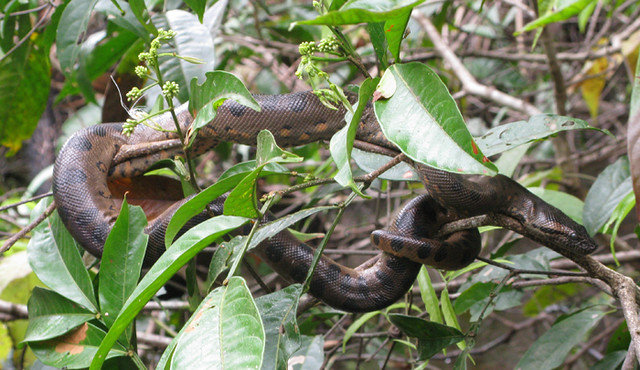The movie Anaconda was a box office hit when it was released in 1997. Starring Jennifer Lopez and telling the story of a group of documentary makers who make enemies with a giant anaconda in the Amazon rainforest, it brought the drama of the jungle to cinema screens and TVs all over the world. Much of the movie was shot in the spectacular landscapes around the Brazilian city of Manaus.
 Anacondas: How deadly?
Anacondas: How deadly?
It doesn’t take long to realize why they chose the anaconda to play the leading role in the movie (no offense J.Lo). Anacondas are one of the most dangerous snakes in the world, not for their bite (they are non-venomous) but for their ability to crush their prey to death. As a water-loving snake they are most likely to eat large fish but have been known to catch caimans and even jaguars in the Amazon jungle.
A debate has raged for many years about the existence of giant anacondas. Doubts persist as to just how large these fearsome snakes can be, with some claiming that anacondas can reach over 60 feet in length while the largest recorded sighting is a ‘mere’ 28 feet. The question remains therefore whether the story of giant snakes in the Amazon is a myth that belongs in the same category as Jurassic Park and King Kong.
Searching for the truth
The search for the giant anaconda was fuelled over 100 years ago when Colonel Percy Fawcett, an early 20th century British explorer, was working in the Amazon on a mission to map parts of the jungle to settle a dispute between rubber producers. Fawcett claimed to have shot an anaconda that was 19 metres (62 feet) from nose to tail. His stories were given little credibility by the scientific community at the time although since then others have suggested that the claims may have been more plausible than first thought.
The biggest challenge to measuring an anaconda is its fondness for remaining at least partially in the water. This makes the task of verifying its full length a difficult one and few people will be happy to jump into the river with a tape measure alongside such a dangerous creature.
Another issue is the ease with which the skin of a dead snake can be stretched, leading to claims of giant snakes that are supported only by a photograph of the snake skin. It is not surprising therefore that the scientific community insists on live capture of an anaconda in order to verify its size; not a small demand considering that the weight of such a giant snake, should it indeed exist, is likely to be close to 2000 lbs.
Eyes on the prize
So why the fascination with finding the elusive giant anaconda? As so often is the case it boils down to money and prestige. The World Conservation Society has put up a prize for the live capture of a snake over 9 metres (30 feet) in length. The prize money currently stands at $50,000 and has never been successfully claimed despite the many alleged sightings.
A stay in hotels in Manaus or even a journey into the jungle is unlikely to reveal any giant snakes. If, however, you have your eye on the $50,000 prize and a lifetime of fame, it may be wise to bring a suitable sized snake container: something about the size of a small house should be sufficient.
Photos | lana.japan, Wikipedia

Comments